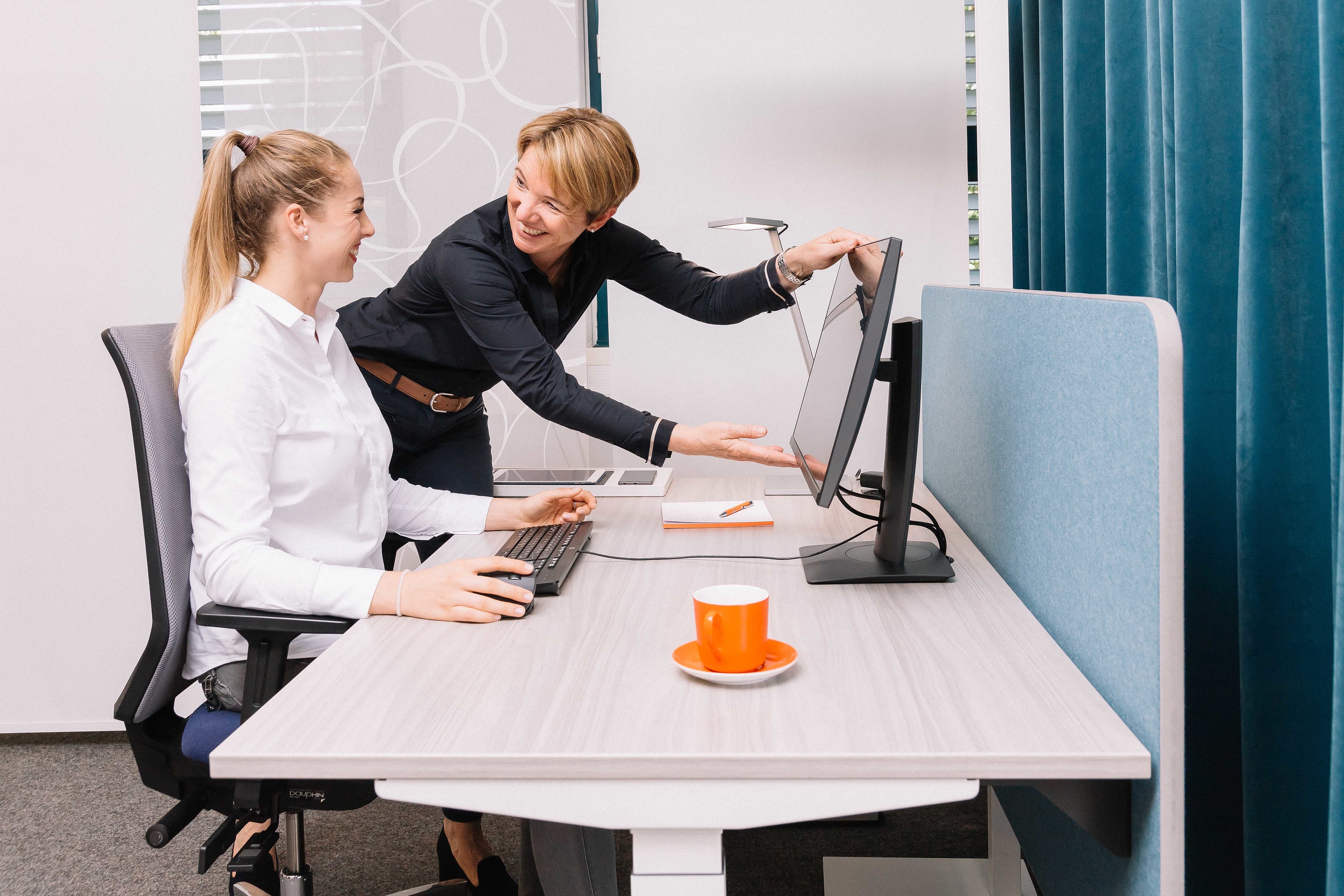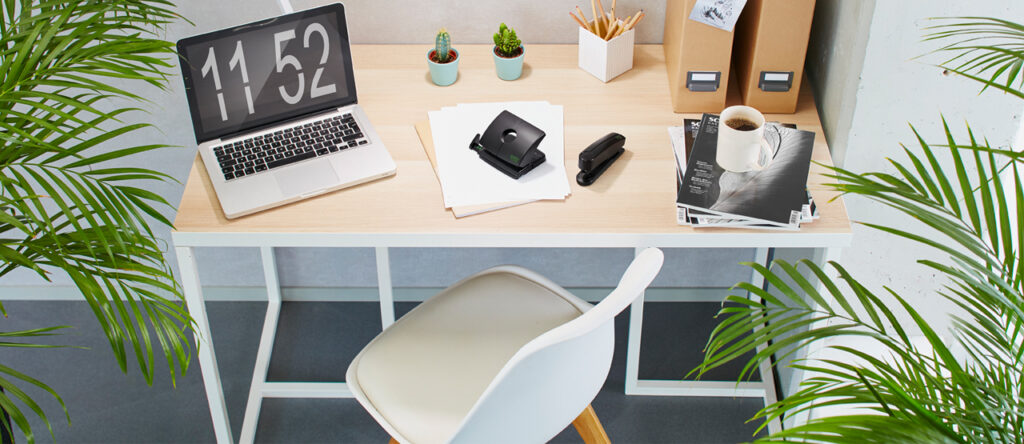How to optimise your home workspace equipment
Working from home is a rising trend. After initial scepticism, more and more employers are agreeing to allow their staff to work from home – at least during the current coronavirus crisis. However, makeshift home workspaces quickly cobbled together bring disadvantages as well as benefits. In this interview, Susanne Weber, a physiotherapist and ergonomic consultant with Ergoimpuls, introduces you to the ergonomic aspects of this trend.
Ms Weber, many companies are currently setting up provisional home workspaces due to the coronavirus lockdown. Could you tell us some common mistakes made, particularly by companies who have previously been rather wary of the topic?
Employees who have always previously worked in company offices, first have to consider various issues: Where can I even set up a workspace in my home? Have I got a separate room available, a suitable table, a suitable chair? Wherever possible, employees should choose a separate area for their workspace. This could be a corner of a room where they can set up their work equipment permanently. The kitchen table is rather unsuitable.
When the boss can’t suddenly appear in your office and if you can’t go outside anyway due to the coronavirus, it is very tempting to lounge on the couch in your sweatpants. What do you think of this?
It is always advisable for employees who work sitting down to do so at a table. Alternatively, they could work standing up at a taller cabinet. A mixture of both would be best. Working on the couch or floor encourages an unfavourable posture and, in the long-term, can cause physical strain and pain. The coronavirus is not about to disappear next week, so home workspaces should be equipped for long-term use.

An ergonomic workspace set-up is critical for employee performance, whether at home or in the company office. I mean, who could just do all their work from a park bench?
Staff working in production naturally have to be on site, but more and more colleagues working in sales, IT, controlling, accounting, marketing, design or communications are enjoying the freedoms conveyed by location-independent working. Many say, “It doesn’t really matter where I work from”. And others dream of working on their laptop by a lake or in a park in the summer, and on the sofa by the fire or in a cosy cafe in winter. Though, whether anyone can concentrate appropriately in these situations is doubtful. And it certainly does not comply with essential ergonomic criteria – ergonomics being the science of the performance capabilities and limits of the working human.
Who is actually responsible for the optimum design of home workspaces?
Employers have a duty of care for the workspace design of every employee, whether at home or on company premises. These workspaces must, of course, fulfil occupational health and safety criteria. The important questions to ask when setting up a workspace are: Has a risk assessment been performed? Does the workspace have sufficient daylight and artificial light ? A number of companies have already made company-wide agreements concerning home workspaces and developed suitable standards. Others are just getting started. I have developed a test for the initial assessment of home workspaces in terms of ergonomics.
What are the most important criteria for creating a good home workspace?
Good employers ensure that their staff have perfectly set-up home workspaces. This includes:
- An individually adjustable office chair
- A height-adjustable table
- A separate screen, also individually adjustable using a monitor support arm
- A separate keyboard and mouse
- Optimum light conditions.
It is not enough to simply provide the employees with these resources; the employees must know how to use them and what really matters.
So, how should one use an office chair, for example? What does it need to be capable of?
The right seat height is important when setting up an office chair. When seated, the knee joints must be positioned vertically above the heels. The chair backrest should be adjusted with the most strongly curved section at belt height. Pressure against the backrest promotes balance and movement when seated. The weight of the arms must be fully borne by the armrests; the upper and lower arms form an angle of approximately 90 degrees. The desk should be adjusted according to the height of the armrests. Most importantly: the shoulders must be relaxed.
The most important tool in the home workspace must surely be the computer. What is essential when it comes to screens?
When adjusting and tilting the screen, you should ensure that you can see the top and bottom lines without moving your head. Good light conditions are also vital. The screen should not be positioned in front of a window. Rather, it should be placed at 90 degrees to the window to prevent glare.

Susanne Weber can also be consulted on the design of home workspaces in person or via video call. A photograph is usually enough for her to make an initial assessment. (Photo: ergoimpuls)
I can’t visit the gym at the moment due to the coronavirus and all sports clubs are closed. How can I keep myself healthy while working from home?
Break up long periods of sitting and stand up when talking on the phone or during video conferences. Changing your position and taking active breaks are effective measures for reducing pain and discomfort in the lower back. I advise people not to remain seated for more than two hours at a time and to get up and walk for five to ten minutes every hour. The same naturally applies when working on company premises. I would be glad to send a five-minute workout video to anyone who is interested. Just a few minutes a day are enough to target and activate the vertebral discs, muscles and fascia to prevent a wide range of discomforts and promote a high level of mental balance.
Thank you very much for speaking to us, Ms Weber!
Wondering how to set up an ergonomic home workspace? Our Novus more-space-system will help you!
A helpful home workspace test
Test your home workspace by answering these questions: If you answer “Yes” twelve to fourteen times, your workspace is ideal. If you answer “Yes” five to eleven times, there is room for improvement. And if you answer “Yes” two to four times, you really need to optimise your workspace.
Workspace location:
|
I always work in a separate office |
yes / no |
|
I always work at a separate workspace in my home |
yes / no |
Working method:
|
I only sit down sometimes when working |
yes / no |
|
I often stand when working |
yes / no |
Office chair:
|
I have a dedicated office chair |
yes / no |
|
I can adjust the height of the seat |
yes / no |
|
I can adjust the backrest |
yes / no |
|
I adjust the chair to suit my requirements |
yes / no |
|
I use the movement/flexibility of the backrest |
yes / no |
Worktop:
|
I have a separate work desk |
yes / no |
|
I have sufficient workspace |
yes / no |
|
I can adjust the height of my desk |
yes / no |
Computer:
|
I work on a laptop with a separate keyboard and screen |
yes / no |
|
I use a separate mouse |
yes / no |
The law states
Legal regulations for remote working
Occupational health and safety requirements apply to normal monitor-based workstations and for remote workstations (working from home).
Par. 2 sentence 7 of the German ordinance on workplaces (ArbStättV/Arbeitsstättenverordnung) states that remote working stations are permanent, monitor-based workstations equipped by the employer in the private household of the employee. The employer and employee must agree a weekly work scheduleand the duration of the arrangement. In addition, the conditions of remote working must be specified in the employment contract or in an agreement. The equipment required for the remote station, including furniture, work tools and communication equipment, must be provided and installed by the employer or by a person appointed by the employer in the private home of the employee. (source: 27th Dresdner Arbeitsschutz-Kolloquium, 6/11/2018: Arbeitsstätten – neue Regelungen und Praxisumsetzung (Workspaces – new regulations and their practical application); Dr Kersten Bux: Anforderungen an Telearbeitsplätze und mobile Arbeit (Requirements for remote working stations and mobile work)
Legal regulations for mobile working
Mobile working relates to employees who can conduct their work at any location, such as at customer premises, on business trips, in hotels or on trains, and therefore do not require a fixed workspace within the company. Mobile working is not subject to the German ordinance on workplaces (ArbStättV).
Also of note: data protection in line with the GDPR is just as important as ergonomics when working from home.
